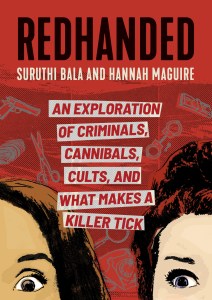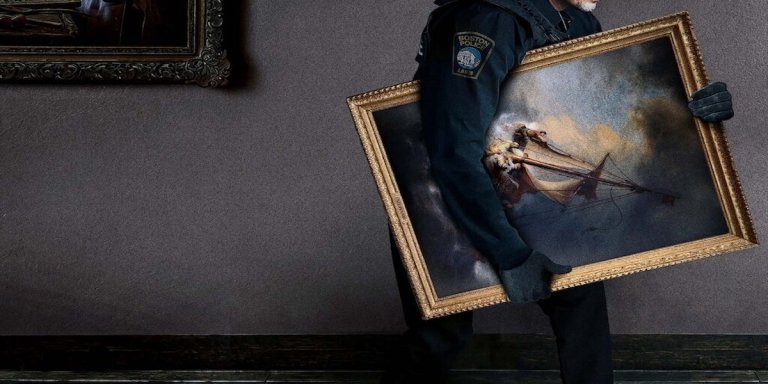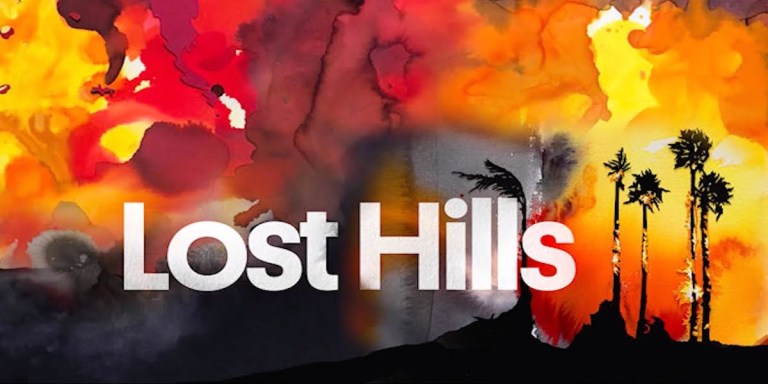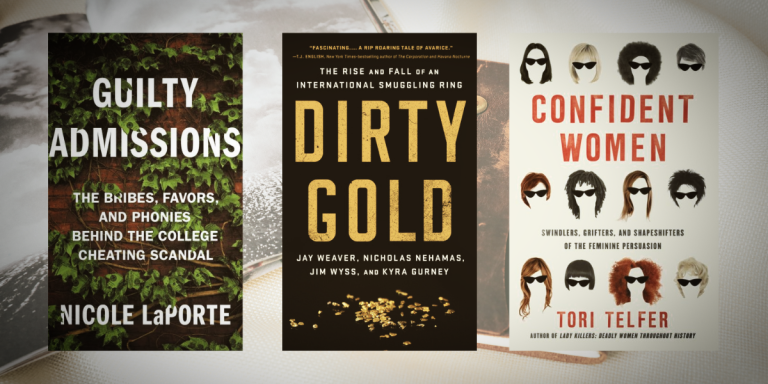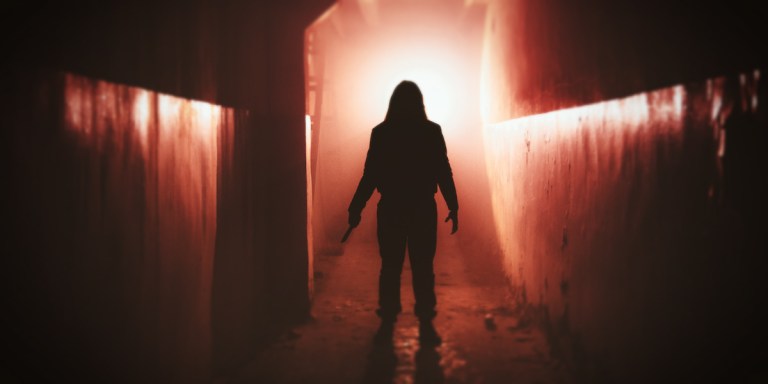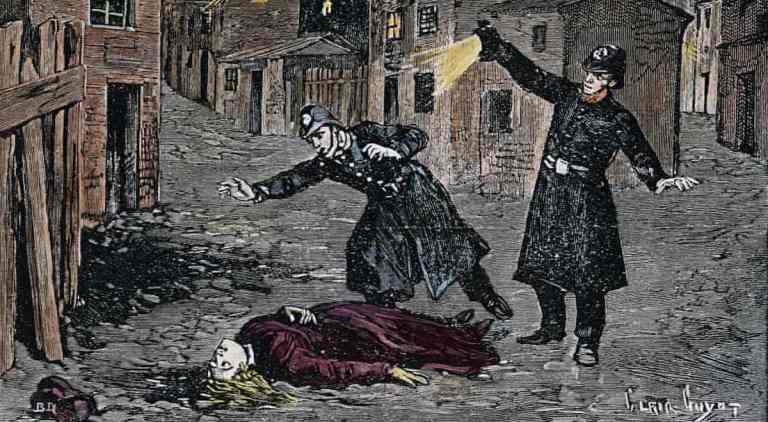The RedHanded Podcast: Murder, True Crime, and Stories That Shock
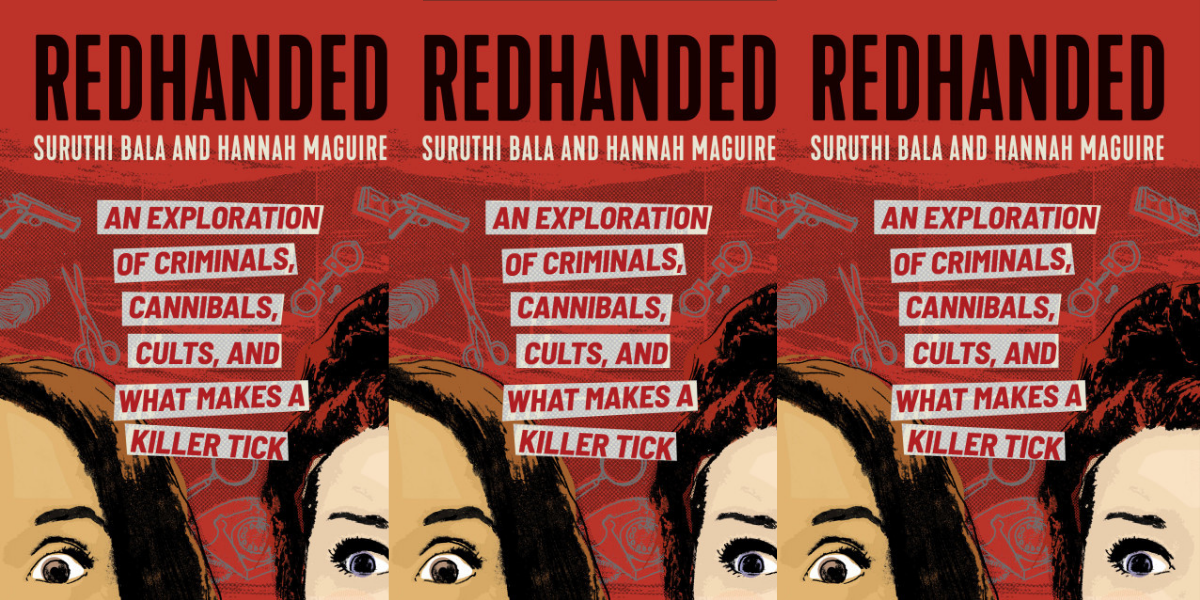 NS: First and foremost, can you share a little bit about yourselves, your work, and how you got started with your podcast?
NS: First and foremost, can you share a little bit about yourselves, your work, and how you got started with your podcast?
SB and HM: Hello! We’re Suruthi Bala and Hannah Maguire hosts of weekly British true crime podcast RedHanded. Every week we release an episode on a brand new case that has caught our attention. And when it comes to what catches our attention, it varies wildy! We are both absolutely fascinated by all sorts of stories – whether it’s huge geopoltical cases like that of Shamima Begum (the London schoolgirl who ran off to join ISIS), or Anders Breveik (the white suprecist who went on a shooting spree in Norway) or the murder of journalist Jamal Khashoggi – to the horrors of familial killings (like that committed by Chris Watts).
We really feel like our niche at RedHanded has become our social commentary on the cases we explore, as well as the analysis of different true crime stories through the perspective of not just psychology, but society, polticals and culture. We never intended for this to happen, but once we started the show we quickly realised that true crime is the absolute perfect mirror to hold up to society and assess everything from inequality, misogyny, bigotry, class, race, justice, feminism and so much more.
We started the podcast 4 and bit years ago after we met, completely by chance, at a party. We didn’t know each other before – but over a few too many glasses of wine we really bonded over our shared love of podcasts and true crime. We left the party with promises of meeting up, neither of us actually thought it would happen, but thankfully we did follow through. We had zero experience in research, broadcasting, audio editing or journalism – but the great thing about podcasts is the low to non-existent barriers to entry. Anyone can buy a £10 mic and get started, and that’s exactly what we did.
Unbelievably the show grew and grew and grew – beyond our wildest expectations and we are grateful daily for the amazing success we have achieved!
NS: What type of research did you do while planning and writing RedHanded?
SB and HM: We are always very clear that we are not investigative journalists, we are storytellers. Our strength lies in putting a story together, telling it in a compelling way, making connections and adding in our own commentary and analysis.
We wanted this book to be a culmination of 4 years of research into true crime that came from the podcast. When we sat down and thought about what we had learned during that time, the key point that we kept coming back to was that although “what makes a killer, kill” is always the most common question we are asked, the answer is so complex and varied – and despite people often wanting to call killer “monsters”, we also knew that usually what led a person to become a killer is something very human indeed.
So we decided that this book would focus on the question of what makes a killer tick, and we woulf focus on 8 factors that impact all of us, and discuss how the perversion of these very human variables can lead to a killer.
For the research we did what we do weekly for the podcast, we devoured books, documentaries and scientific articles galore to help us set out a well-argued narrative for each point we wanted to make.
NS: You have both heard dozens and dozens of true crime stories. Has there ever been a story that shocked you beyond what you expected or stuck with you the most whether it be because of the events of the crime, the investigation, or any other aspect of the case?
SB and HM: There have been many cases that have hit us hard over the years, and sometimes it will be a really expected part of the story hurts the most. But in terms of cases that stuck around in our heads the longest, it would have to be Junko Furuta and David Parker Ray.
Junko Furuta was a young girl was murdered by a group of boys in Japan in 1989, she was abducted from the streets and tortured in horrendous ways for 6 weeks before she was eventually killed and her body encased in concrete. It’s a case we don’t feel we’ll ever want to cover because the research would just be far too much.
The case of David Parker Ray is actually a story that has made it into the book in the chapter on Sex. Ray was a sexual sadist who would abudct women and keep them prisoner in a trailer he nicknamed The Toybox.
Needless to say the horrors he inflicted on these women are some of the worst things we have ever read about and it makes of very difficult reading.
NS: You mention, rightfully so, the responsibility viewers who consume these kinds of true crime stories as a form of entertainment have to not only learn from them but also to advocate for the victims of these crimes…or at the very least, respect their stories. This is a problem I’ve encountered as a true crime viewer myself, whether it’s people bad-mouthing victims in comment sections or glorifying multiple murder. What tips have you learned on how to be a responsible true crime viewer that you can pass on to our readers?
SB and HM: I think it is to challenge everything. Books, documentaries, articles, podcasts – whatever it may be, to be a responsible consumer of true crime what we need to do is question and challenge everything.
As we mentioned earlier, true crime is the perfect mirror for us to reflect on our society. It’s only by having been a fan of true crime have I woken up to a lot of societies issues like racism in the justice system, how misogyny literally kills through loopholes like the “rough sex defence”, why we still view some in soicety as being the “less dead” and why we still perpetuate harmful ideas around victims having “asked for it”. If true crime can open peoples’ eyes to injustice and allow them to explore victims’ (and killers’) stories in a deeper way, enabling all of us to develop a deeper sense of empathy – that can only be a good thing.
NS: Back to your book RedHanded. In RedHanded, you explore the minds of serial killers, cannibals, cult leaders (the worst of the worst) and you do it with biting humor that brings a much-needed relief to the otherwise serious content you’re unpacking. What’s your secret to balancing comedy and horror?
SB and HM: I really don’t know if there is a secret, I think the key to how we approach it at RedHanded is, we’re dealing with very difficult subject matters, and people have lost their lives. That will never be funny. But we can look for the comic relief around all of the pain, and we can certainly laugh at the killers. We always just try to stay true to our values, respect the victims and allow people to explore these stories without feeling absolutely miserable by the end of it!
NS: Besides Ted Bundy, what infamous serial killers do you think are overhyped in the media and in the true crime community?
SB and HM: Soooo many! We really have picked a few killers and just fetisihed them to unimaginable levels. Did you know there is a serial killer colouring book featuring the likes of Bundy, Kemper, Gacy and Dahmer that you can buy on Etsy?!
It’s hard to say who is more overhyped than Bundy, but the colouring book really highlights the key players in this weird fame-game!
NS: Alongside your podcast, is there anything you’re currently working on that you can share? What are you currently watching, reading, or listening to?
SB and HM: We’re constantly working on something new! Our main focus for now is continuing to grow RedHanded the podcast, but we’re exploring options to start some new more niche shows!
We’re currently listening to the podcast Conflict of Interest! We recently covered the case of Shamima Begum and we fell down a huge ISIS rabbit hole. And we were so delighted to be invited to host the 9/11 special of Conflict of Interest, where we got to interview Moshin Hamid – the author of The Reluctant Fundemalist – about all things Al-Qaeda, ISIS and Taliban.
Hello! We’re Suruthi Bala and Hannah Maguire hosts of weekly British true crime podcast RedHanded. Every week we release an episode on a brand new case that has caught our attention. And when it comes to what catches our attention, it varies wildy! We are both absolutely fascinated by all sorts of stories – whether it’s huge geopoltical cases like that of Shamima Begum (the London schoolgirl who ran off to join ISIS), or Anders Breveik (the white suprecist who went on a shooting spree in Norway) or the murder of journalist Jamal Khashoggi – to the horrors of familial killings (like that committed by Chris Watts).
We really feel like our niche at RedHanded has become our social commentary on the cases we explore, as well as the analysis of different true crime stories through the perspective of not just psychology, but society, polticals and culture. We never intended for this to happen, but once we started the show we quickly realised that true crime is the absolute perfect mirror to hold up to society and assess everything from inequality, misogyny, bigotry, class, race, justice, feminism and so much more.
We started the podcast 4 and bit years ago after we met, completely by chance, at a party. We didn’t know each other before – but over a few too many glasses of wine we really bonded over our shared love of podcasts and true crime. We left the party with promises of meeting up, neither of us actually thought it would happen, but thankfully we did follow through. We had zero experience in research, broadcasting, audio editing or journalism – but the great thing about podcasts is the low to non-existent barriers to entry. Anyone can buy a £10 mic and get started, and that’s exactly what we did.
Unbelievably the show grew and grew and grew – beyond our wildest expectations and we are grateful daily for the amazing success we have achieved!
NS: What type of research did you do while planning and writing RedHanded?
SB and HM: We are always very clear that we are not investigative journalists, we are storytellers. Our strength lies in putting a story together, telling it in a compelling way, making connections and adding in our own commentary and analysis.
We wanted this book to be a culmination of 4 years of research into true crime that came from the podcast. When we sat down and thought about what we had learned during that time, the key point that we kept coming back to was that although “what makes a killer, kill” is always the most common question we are asked, the answer is so complex and varied – and despite people often wanting to call killer “monsters”, we also knew that usually what led a person to become a killer is something very human indeed.
So we decided that this book would focus on the question of what makes a killer tick, and we woulf focus on 8 factors that impact all of us, and discuss how the perversion of these very human variables can lead to a killer.
For the research we did what we do weekly for the podcast, we devoured books, documentaries and scientific articles galore to help us set out a well-argued narrative for each point we wanted to make.
NS: You have both heard dozens and dozens of true crime stories. Has there ever been a story that shocked you beyond what you expected or stuck with you the most whether it be because of the events of the crime, the investigation, or any other aspect of the case?
SB and HM: There have been many cases that have hit us hard over the years, and sometimes it will be a really expected part of the story hurts the most. But in terms of cases that stuck around in our heads the longest, it would have to be Junko Furuta and David Parker Ray.
Junko Furuta was a young girl was murdered by a group of boys in Japan in 1989, she was abducted from the streets and tortured in horrendous ways for 6 weeks before she was eventually killed and her body encased in concrete. It’s a case we don’t feel we’ll ever want to cover because the research would just be far too much.
The case of David Parker Ray is actually a story that has made it into the book in the chapter on Sex. Ray was a sexual sadist who would abudct women and keep them prisoner in a trailer he nicknamed The Toybox.
Needless to say the horrors he inflicted on these women are some of the worst things we have ever read about and it makes of very difficult reading.
NS: You mention, rightfully so, the responsibility viewers who consume these kinds of true crime stories as a form of entertainment have to not only learn from them but also to advocate for the victims of these crimes…or at the very least, respect their stories. This is a problem I’ve encountered as a true crime viewer myself, whether it’s people bad-mouthing victims in comment sections or glorifying multiple murder. What tips have you learned on how to be a responsible true crime viewer that you can pass on to our readers?
SB and HM: I think it is to challenge everything. Books, documentaries, articles, podcasts – whatever it may be, to be a responsible consumer of true crime what we need to do is question and challenge everything.
As we mentioned earlier, true crime is the perfect mirror for us to reflect on our society. It’s only by having been a fan of true crime have I woken up to a lot of societies issues like racism in the justice system, how misogyny literally kills through loopholes like the “rough sex defence”, why we still view some in soicety as being the “less dead” and why we still perpetuate harmful ideas around victims having “asked for it”. If true crime can open peoples’ eyes to injustice and allow them to explore victims’ (and killers’) stories in a deeper way, enabling all of us to develop a deeper sense of empathy – that can only be a good thing.
NS: Back to your book RedHanded. In RedHanded, you explore the minds of serial killers, cannibals, cult leaders (the worst of the worst) and you do it with biting humor that brings a much-needed relief to the otherwise serious content you’re unpacking. What’s your secret to balancing comedy and horror?
SB and HM: I really don’t know if there is a secret, I think the key to how we approach it at RedHanded is, we’re dealing with very difficult subject matters, and people have lost their lives. That will never be funny. But we can look for the comic relief around all of the pain, and we can certainly laugh at the killers. We always just try to stay true to our values, respect the victims and allow people to explore these stories without feeling absolutely miserable by the end of it!
NS: Besides Ted Bundy, what infamous serial killers do you think are overhyped in the media and in the true crime community?
SB and HM: Soooo many! We really have picked a few killers and just fetisihed them to unimaginable levels. Did you know there is a serial killer colouring book featuring the likes of Bundy, Kemper, Gacy and Dahmer that you can buy on Etsy?!
It’s hard to say who is more overhyped than Bundy, but the colouring book really highlights the key players in this weird fame-game!
NS: Alongside your podcast, is there anything you’re currently working on that you can share? What are you currently watching, reading, or listening to?
SB and HM: We’re constantly working on something new! Our main focus for now is continuing to grow RedHanded the podcast, but we’re exploring options to start some new more niche shows!
We’re currently listening to the podcast Conflict of Interest! We recently covered the case of Shamima Begum and we fell down a huge ISIS rabbit hole. And we were so delighted to be invited to host the 9/11 special of Conflict of Interest, where we got to interview Moshin Hamid – the author of The Reluctant Fundemalist – about all things Al-Qaeda, ISIS and Taliban.
Order the Book
What is it about killers, cult leaders, cannibals, cults, and criminals that capture our imaginations even as they terrify and disturb us?
How do we responsibly consume these kinds of stories as entertainment, and more importantly, what can we learn from them? RedHanded rejects the narrative of killers as monsters and that a victim "was in the wrong place at the wrong time," and instead tells the stories we want to hear in a way that challenges perceptions and asks the hard questions about society, gender, poverty, culture, and even our politics.
After meeting at a party in London where they both discovered they listened to the same murder podcasts, Hannah Maguire and Suruthi Bala drunkenly promised to one day start their own true crime podcast together and the rest is history. From the hosts of the hit true crime podcast RedHanded (dubbed by Rick & Morty creator Dan Harmon as the "best true crime podcast I've heard, ever"), Hannah Maguire and Suruthi Bala have amassed a cult following of "spooky bitches" amounting to an incredibly strong 63k downloads per episode and 728k backlist downloads every month in the US alone.
With candor, humor, interviews with experts, research on real-life cases, and an unflinching dissection of what makes a killer tick, Bala and Maguire take us through the societal, behavioral, and cultural phenomena that make victims—and their murderers—our collective responsibility and to find out once and for all: what makes a killer tick?
By clicking 'Sign Up,' I acknowledge that I have read and agree to Hachette Book Group’s Privacy Policy and Terms of Use
What to Read Next
